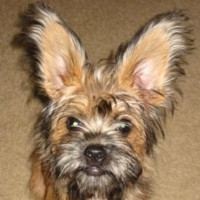Appearance of the Papigriffon
|
| The Papigriffon has a sturdy little body, short legs and often has a feathered tail that curls over its back. It packs a lot of muscle into its small body and can move very quickly. Delicate little feet help it turn quickly, while a strong chest and neck help it keep its balance. Your Papigriffon's face can vary from flat and short to pointed and delicate, depending on the genetic influence of the parent dog. Ears are often straight and pointed, with longer hairs decorating the edges. The round, dark eyes have a mischievous gleam, and the shiny black nose is small and delicate. The coat can vary from medium length, with feathers around the chest, ears and legs, to dense. But whatever its appearance, the Papigriffon is a great little dog with a gentle heart and a loving, devoted nature. |
Temperament of the Papigriffon
|
| Cute, sweet, affectionate and full of life describes the Papigriffon perfectly. But don't think this dog is angelic; he can be bossy at one end of the scale and sensitive and cautious at the other. Much depends on your positive training and how much socialization your puppy receives early in life. They can be a bit clingy for some people, as these dogs bond with you and will want to be with you wherever you go. They don't like to be alone and will get into all sorts of mischief if you leave them alone. Papigriffons are family dogs who think they're human, so they expect privileges from their owners, like sleeping on or in the bed with you. But it's hard to resist their pleading faces and loving affection when they get what they want. Don't give in to their every whim or you could end up with a very bossy dog. They adapt well to apartment life and will get most of their exercise following you around the house or helping the kids with whatever they're doing. Real little busybodies, they're everywhere. Although they're small, they're not fragile. They are robust little dogs who respond well to training, positive instructions and small rewards for good behavior. Full of character and appeal, these feisty little dogs will take every opportunity to snuggle in your lap and bask in your adoration. |
Needs and activities of the Papigriffon
|
| The Papigriffon is an active dog, ranging from those who are slightly active to those who are just full. They'll enjoy a walk with you, happy to trot alongside you as you stroll around the neighborhood. It's advisable to keep them on a leash, as strong hunting instincts can see them chasing a bird or small animal, ignoring all your shouted commands to return. A dog park is ideal where you can remove the leash and let them run with their companions in a fenced-in area. These little dynamos will enjoy most games, relishing the challenge of beating your efforts to outdo them. If your Papigriffon has the flat face and short nose of the Brussels Griffon, be aware that it can be affected by high heat and suffer respiratory problems in the heat. Be sure to exercise them only in the cooler hours of the day. |
Maintenance of the Papigriffon
|
| The intensity of care depends on the coat it inherits. Whether it's wiry or silky, you'll need to brush it at least every other day just to avoid tangles. Some coats may need to be stripped if they're mainly wiry, to help the coat grow in better. A professional groomer may simply have to come and tidy up your Papigriffon. These dogs love attention, so they'll be happy to sit while you brush, comb and bathe them occasionally. Don't forget to use a gentle dog shampoo to help preserve the skin's natural oils and prevent allergies. Their little teeth will need brushing at least twice a week, to keep your breath soft. These ears need a quick check to see if there's an accumulation of dirt causing inflammation. Gently wipe the inner ear with a damp cloth, but never put anything in the inner ear as you could damage their hearing. Apart from a quick pair of nail clippers and a little cuddle, you can conclude that the maintenance is done. |









 English (United Kingdom)
English (United Kingdom)